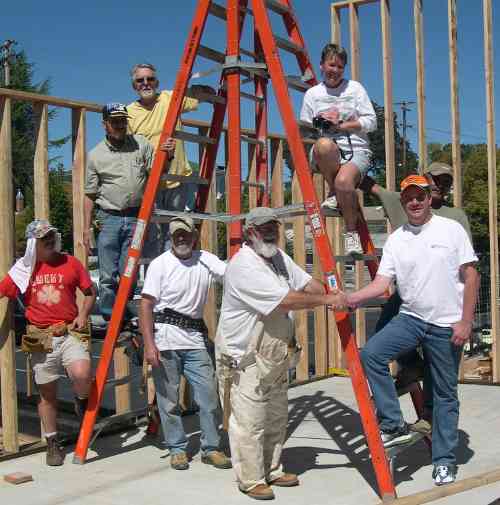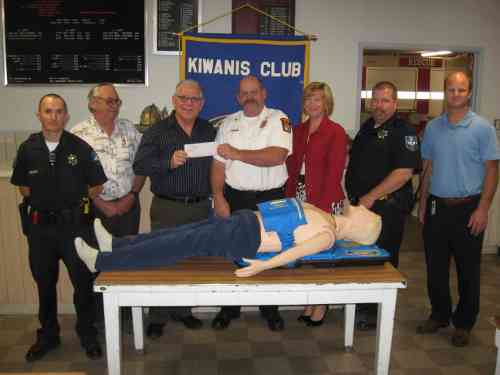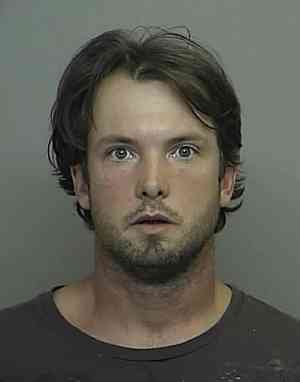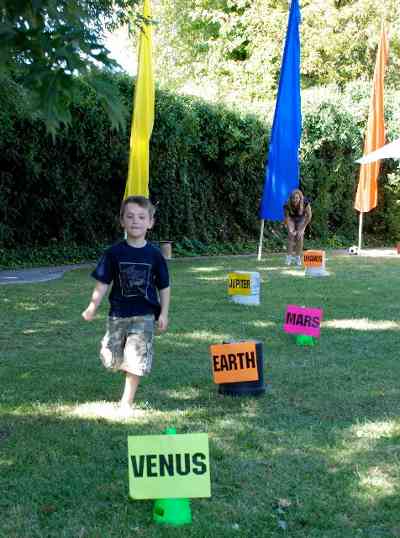
Alex Hadgis of Kelseyville, Calif., runs the Solar System Slalom. Photo courtesy of Nancy Brier.
LAKE COUNTY, Calif. – A lucky handful of Lake County elementary students ended summer with a blast this year at Camp Walla Walla Hoo Ha, a hands-on science exploration camp where science and art collide.
Fifteen young campers were greeted with puzzling questions: If the sun were the size of a front door, how big would earth be? If the sun were the size of a grapefruit, how far away would Pluto be?
Campers explored these questions and dozens more of their own in a fast-paced, action-packed week of science, crafts, physical fitness and performing arts.
On day one, campers built a model of the solar system. It was massive, the huge globular sun dangling from a sturdy tree limb, and it stayed on display at camp all week to serve as a fun artistic centerpiece and an excellent point of reference for space related questions.
An 8-foot sphere, the sun glowed red, yellow and orange with flickers of purples and blues. Planets were built to scale, with Jupiter being about the size of a basketball and Saturn stealing all the glory with its magnificent rings.
Building this giant system helped put the incomprehensible nature of space into a more down to earth realm, and it made the campers hungry.
After a fortifying snack and a spirited round of rocket relay races, campers created individual 3-D solar system models of their own to take home.
“I want to live at space camp,” said 6-year-old Aiden Hall, a particularly ardent fan of science.
Camp Walla Walla Hoo Ha, whose mission is to bring science to life and inspire school age children to improve skills in science, technology, engineering, and math, debuted this summer in Lake County. Plans to expand the program are under way.
“Six months ago, I heard a Silicon Valley executive literally pleading for more science education in California,” said camp founder Nancy Brier, a Lake County entrepreneur with a strong interest in education.
According to STEM, a Silicon Valley foundation that encourages education in science and technology, California ranks second to the bottom nationally in science education among eighth graders, but Brier said she believes that small steps can turn these numbers around.
“I’d like to see Lake County take a leadership role in the shift,” she said.
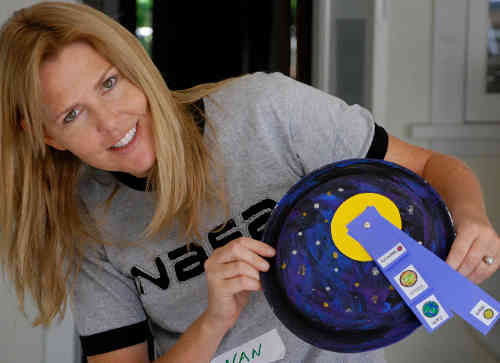
Space camp instructor Nancy Brier demonstrates a model of the inner planets at Camp Walla Walla Hoo Ha. Photo courtesy of Nancy Brier.
By day two, campers were ready to explore in depth the inner planets: Mercury, Venus, Earth, Mars and the asteroid belt.
They learned that the inner planets are mostly made up of rock, that they are relatively close to the sun and that they orbit faster than the outer planets.
Each camper made his own replica of the inner planets, and their replicas actually revolve on their own orbital paths, an artistic keepsake and a scientifically accurate representative of the day’s theme at camp.
“It was so much fun,” said an exuberant Michael Wiser of Kelseyville, just as day two ended.
His mother, Meredith Wiser, said she couldn’t believe how much Michael was learning. “It's all he talks about, and the knowledge he’s acquiring is amazing,” she said.
On day two, each camper also selected a role to play in a performance called “The Living Solar System,” presented by the Milky Way Players at week’s end. Campers made their own costumes and rehearsed all week to portray their best interpretation of the planets, the asteroid belt, space explorers and other roles which reinforced the core learning of the week.
The third day of camp offered a closeup look at the sun, the moon and the earth. Campers split up and visited stations all over the campground to discuss specifics and conduct experiments.
At the moon station, campers studied NASA photos of craters on the surface of the moon. Campers then recreated the moon surface, and using various sized “asteroids” projected at differing angles and speeds, made their own craters and discussed them.
They also looked at photos showing shadows cast on the earth by the moon and learned about the how our view of the moon changes during its various phases. Many campers were shocked to learn that the earth is actually larger than the moon.
At the earth station, campers learned about polar ice caps, the earth’s axis and equator, and how the earth moves relative to the sun.
At the last station, campers visited the sun itself, where a 3-D poster showed in amazing detail what the surface of the sun actually looks like.
They compared that poster to the flame of a candle and discussed the impact of heat on earth and other planets.
Campers tossed pebbles into a plastic container decorated with the sun’s image. If those pebbles represent earth, it would take a million to fill the sun.
That afternoon, campers recreated the view of earth from space with a 3-D craft that included topographical land masses, the equator and the earth’s axis.
For 5-year-old Audrey Dierssen of Kelseyville, the earth project was a favorite. “I liked making the land and mixing them with paint, and I loved getting the earth tattoo from NASA.”
Contributions and consultations from professionals at Jet Propulsion Labs in Los Angeles helped furnish the camp with educational materials, cool tattoos and stickers.
Day four shifted the focus to the outer planets, which are mostly gas.
“Making our own gas planet was cool,” reported Miles Mattina of Lakeport.
Campers discussed how the outer planets, other than Pluto, are generally large, made of gas and orbit slowly. At craft time, they replicated Saturn in a craft that mimics Saturn’s glamorous rings of ice and dust.
Lots of physical activity punctuated the science activities at camp. Six-year-old Lauren Trippeer especially liked the Solar System Slalom, an obstacle course in which campers made timed runs around the planets in order.
Starting at the sun, each camper had to make a complete orbit around each planet and race back to the finish line while another camper documented the score. “It was awesome,” Lauren exclaimed, panting and red faced.
By Friday, campers were eager to show off their knowledge, and parents and family members were invited to join the fun.
As a warmup to the performance, campers challenged parents to a game of space trivia, a match that put the parents to shame. Campers eagerly raised their hands to each and every space related question, while parents, mostly mystified, could only guess at the answers they may have known long ago.
To answer the opening questions: if the sun were the size of your front door, Earth would be about the size of a nickel. And if the sun were the size of a grapefruit, Pluto would be about a half a mile away.
Camp Walla Walla Hoo Ha culminated just as the school year gets under way.
Perhaps the most promising moment of the action-packed week came at the very end when 6-year-old camper Clara Andre was overheard to say, “This year, I’m going to ask my teacher for more science.”
For more information about the camp, contact Nancy Brier at This email address is being protected from spambots. You need JavaScript enabled to view it..
Follow Lake County News on Twitter at http://twitter.com/LakeCoNews and on Facebook at http://www.facebook.com/pages/Lake-County-News/143156775604?ref=mf .
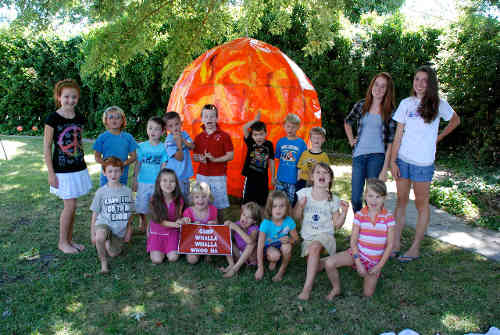
Participants in the inaugural Camp Walla Walla Hoo Ha included, back row, left to right

